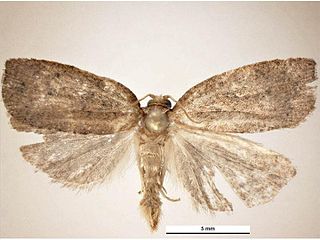Ctenopseustis is a genus of moths belonging to the subfamily Tortricinae of the family Tortricidae.
Apoctena is a genus of moths belonging to family Tortricidae.
Leucotenes is a genus of moths belonging to the family Tortricidae.

Planotortrix octo is a moth of the family Tortricidae. It is endemic to New Zealand, where it is found in both the North and South islands.

Ctenopseustis fraterna, the brownheaded leafroller, is a species of moth of the family Tortricidae. It is found in New Zealand, where it has been recorded from the North Island only. The common name is also used for the related species Ctenopseustis herana and Ctenopseustis obliquana.
Ctenopseustis servana is a species of moth of the family Tortricidae. It is found in New Zealand, where it has been recorded from the North Island and the Three Kings Islands.
Leucotenes coprosmae is a species of moth of the family Tortricidae. It is found in New Zealand, where it has been recorded from the North and South islands, as well as Stewart Island.
Planotortrix octoides is a species of moth of the family Tortricidae. It is endemic to New Zealand, where it has been recorded from the Chatham Islands only.
Planotortrix puffini is a species of moth of the family Tortricidae. It is endemic to New Zealand. Specimens have been collected from Lee Bay in Stewart Island.

Planotortrix notophaea, the blacklegged leafroller, is a species of moth in the family Tortricidae. It is endemic to New Zealand. It was also present near Sydney in Australia, but this population is thought to be extinct.

Apoctena clarkei is a species of moth of the family Tortricidae. It is found in New Zealand, where it is only found on the North Island.

Apoctena conditana is a species of moth of the family Tortricidae. It is found in New Zealand, where it is found on both the North and South islands.

Apoctena flavescens is a species of moth of the family Tortricidae. It is found in New Zealand, where it is found on both the North and South islands.
Apoctena orthropis is a species of moth of the family Tortricidae. It is found in New Zealand, where it is found on both the North and South islands.
Apoctena taipana is a species of moth of the family Tortricidae, endemic to New Zealand. The current combination dates from Dugdale (1990). Note that Cacoecia enoplana Meyrick, 1882 is a junior subjective synonym.
Apoctena syntona is a species of moth of the family Tortricidae. It is found in New Zealand.
Apoctena pictoriana is a species of moth of the family Tortricidae. It is found in New Zealand, where it is found on both the North and South islands.
Apoctena spatiosa is a species of moth of the family Tortricidae. It is found in New Zealand, where it is located on both the North and South islands.

In computing, a digital object identifier (DOI) is a persistent identifier or handle used to identify objects uniquely, standardized by the International Organization for Standardization (ISO). An implementation of the Handle System, DOIs are in wide use mainly to identify academic, professional, and government information, such as journal articles, research reports and data sets, and official publications though they also have been used to identify other types of information resources, such as commercial videos.












